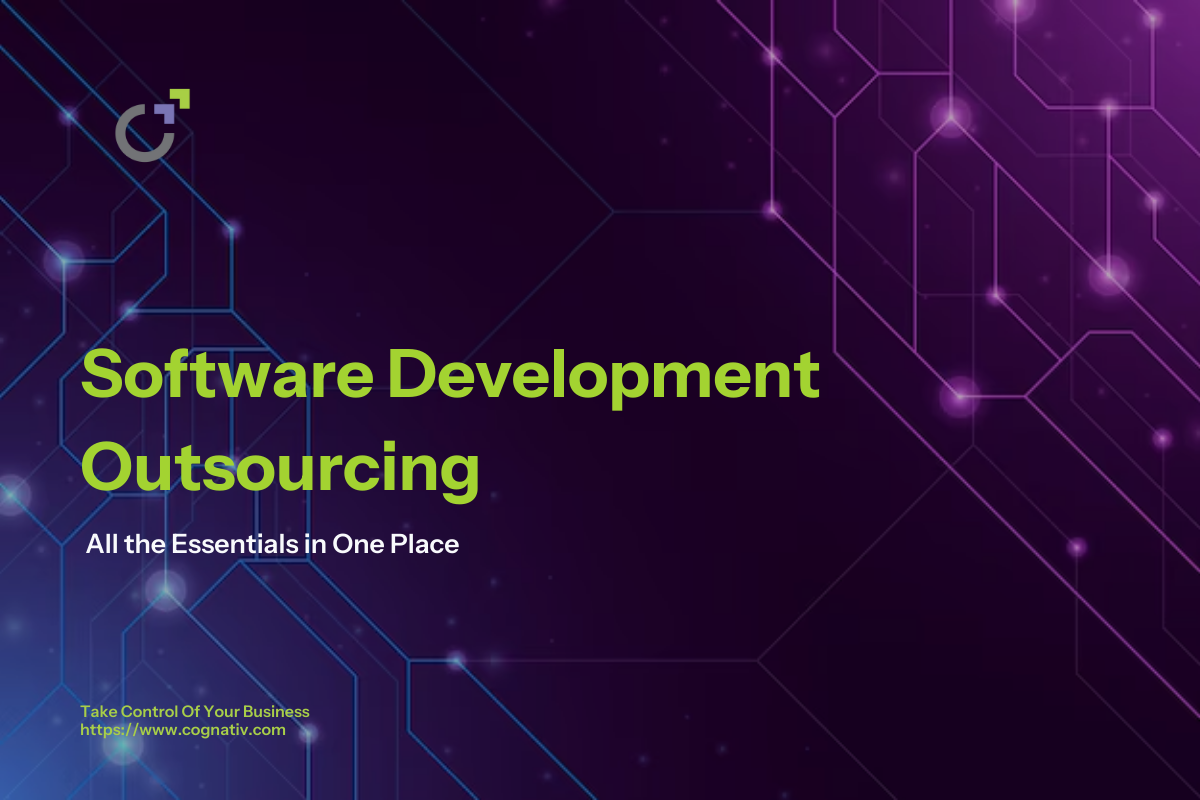

Tuesday, March 25, 2025
Kevin Anderson
Software Development Outsourcing: All the Essentials in One Place
Software development outsourcing continues to be a powerful strategy for organizations seeking efficiency, technical specialization, and accelerated product delivery. By delegating software‑related tasks to an external team or firm, businesses can reduce overhead costs, access global talent pools, and maintain agility in a competitive market.
This comprehensive guide covers all the critical aspects of outsourcing software development in 2025: definitions, engagement models, benefits, potential risks, best practices, and how to select the right vendor for your project needs.
Table of Contents
- What Is Software Development Outsourcing?
- Why Do Companies Outsource Software Development?
- Common Outsourcing Models in Software Development
- How to Build an Effective Outsourcing Strategy
- Top Risks in Outsourcing—and How to Mitigate Them
- Cost Considerations by Region (2025 Estimates)
- Frequently Asked Questions About Outsourcing
- Final Thoughts

What Is Software Development Outsourcing?
Software development outsourcing refers to the practice of hiring external vendors to handle part or all of a software project. Depending on the organization’s objectives, this can include front‑end and back‑end development, user interface and user experience (UI/UX) design, quality assurance (QA) and testing, DevOps and infrastructure management, full‑stack product development, and ongoing support and maintenance. Outsourced software development can be structured in different ways—ranging from fully remote, offshore teams to nearshore collaborations that improve time zone compatibility.
Some companies even employ a hybrid model by combining external contractors with in‑house developers. This approach allows organizations to focus on their core business while leveraging specialized expertise and resources that may not be available internally. It also helps reduce overhead costs and accelerate time‑to‑market, making it an attractive option in a competitive environment where technology evolves rapidly.
Common Services Provided by Outsourcing Firms
Software development outsourcing firms typically offer a wide range of services, including full-stack development, mobile app creation, API integration, DevOps, cloud migration, quality assurance, and UI/UX design. Depending on the vendor's capabilities, you may also access niche expertise in areas like AI, IoT, or cybersecurity. Choosing the right service mix depends on your project's goals and technical complexity.
Outsourcing vs. In-House Development: Key Differences
While in-house teams offer greater control and brand alignment, outsourcing provides agility, lower costs, and access to specialized skill sets. Outsourcing allows companies to ramp up quickly without long recruitment cycles, whereas in-house hiring offers deeper integration but at a higher fixed cost. The best approach often involves a strategic blend of both models, depending on scale, urgency, and resource availability.
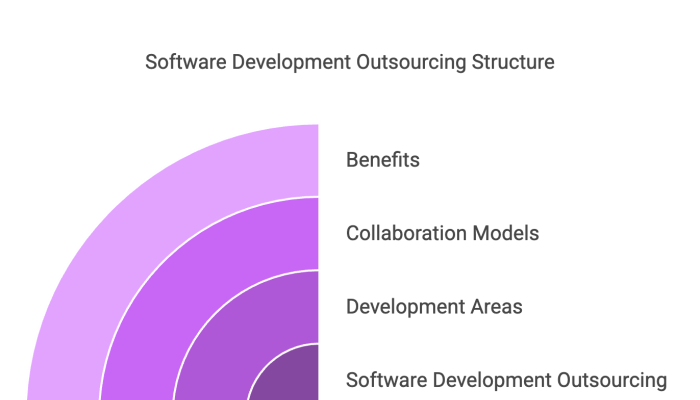

Why Do Companies Outsource Software Development?
Companies outsource software development to access specialized expertise and achieve faster time‑to‑market. Outsourcing enables businesses to tap into global talent pools that possess niche technical skills—such as artificial intelligence, cybersecurity, machine learning, blockchain, and embedded systems—without incurring the long‑term costs associated with hiring full‑time staff.
This model not only accelerates product delivery but also provides flexibility in scaling development resources up or down based on project demands. Additionally, outsourcing allows internal teams to focus on core business functions like strategy, marketing, and innovation, while external experts handle the technical complexities. The cost savings extend beyond salaries, as outsourcing can reduce expenditures on equipment, infrastructure, HR, and onboarding.
Ultimately, outsourcing is a strategic tool that helps companies remain agile and competitive in a fast‑paced market by aligning technical execution with broader business goals.
How Outsourcing Enhances Innovation?
Outsourced teams often bring fresh perspectives and exposure to a broader range of technologies and industries. This cross-pollination of ideas accelerates innovation, enabling companies to implement advanced solutions—such as AI-powered analytics or serverless architecture—without building in-house expertise from scratch. Innovation thrives when you leverage global talent strategically.
Business Scenarios Where Outsourcing Excels
Outsourcing is especially effective for projects like MVP development, legacy system modernization, or scaling SaaS platforms. It also suits companies with temporary technical needs, such as compliance updates or building integrations with third-party services. The ability to scale up or down as needed adds flexibility for businesses managing seasonal or fluctuating workloads.
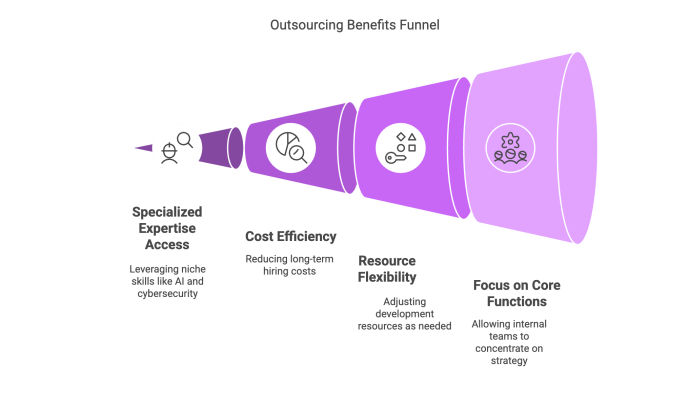

Common Outsourcing Models in Software Development
There are several models for outsourcing software development, each designed to meet different project requirements and risk tolerances. The three most popular models include Time‑and‑Materials (T&M), Fixed Price (FP), and Dedicated Team arrangements. Time‑and‑Materials models are ideal when project scopes are expected to evolve, as they offer flexibility and allow you to pay for actual hours worked. Fixed Price models, on the other hand, are best suited for projects with well‑defined requirements, as they provide budget predictability and minimize management overhead.
A Dedicated Team model involves an external team working exclusively on your project over the long term, ensuring deep integration and consistent output. Additionally, organizations sometimes choose between nearshore and offshore outsourcing depending on factors like time zone alignment and cost efficiency. Each model presents its own set of advantages and challenges, so selecting the right one depends on your project's complexity, budget, and strategic objectives.
Choosing the Right Engagement Model
Deciding between time and material, fixed-price, or dedicated team models requires careful analysis of project scope, flexibility, and risk tolerance. Time and material works well for evolving requirements, while fixed-price suits defined scopes. Dedicated teams are best for long-term, domain-intensive projects where deep collaboration is key.
Hybrid Models and When to Use Them
Hybrid outsourcing models combine elements of multiple engagement types to meet complex needs. For instance, you might use a fixed-price model for core features and a time and material setup for ongoing enhancements. Hybrid models offer a balance between cost control and adaptability, ideal for iterative development in agile environments.
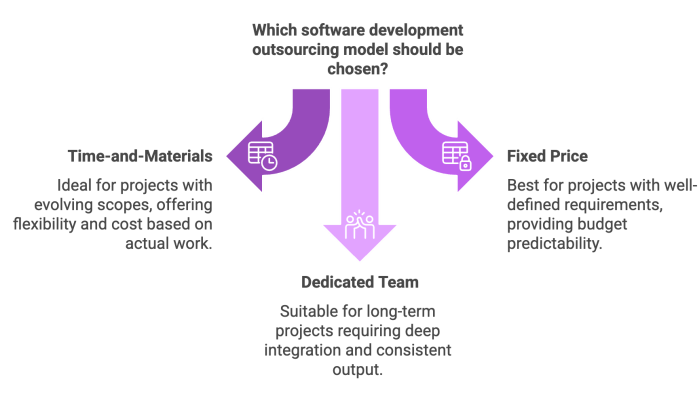

How to Build an Effective Outsourcing Strategy?
To ensure a successful outsourcing initiative, it is vital to develop a clear and effective strategy. Begin by defining precise project goals, target timelines, and key performance indicators (KPIs). Establish which components of your project—such as front‑end development, DevOps, or QA—will be outsourced and what tasks will remain in‑house. Next, choose the appropriate engagement model that best fits your project’s scope and risk tolerance, whether that be T&M, Fixed Price, or a Dedicated Team approach.
Once you have a solid framework in place, thoroughly evaluate potential vendors based on their technical capabilities, industry experience, and cultural fit. Develop a strong communication framework using collaborative tools like Jira or Trello to maintain transparency and regular feedback throughout the project lifecycle. Finally, sign a comprehensive contract that details deliverables, timelines, payment structures, and legal safeguards such as NDAs and IP rights to protect your interests and ensure accountability.
Steps to Build an Effective Outsourcing Roadmap
Begin by defining your core objectives and identifying which tasks can be outsourced without compromising business continuity. Align your vendor selection with your technology stack, compliance needs, and communication preferences. Establish clear timelines, milestones, and deliverables before onboarding any external team.
Vendor Vetting Criteria That Matter
Look beyond pricing when choosing a software development outsourcing company. Evaluate case studies, verify certifications, assess technical depth, and review their onboarding process. Also, ensure cultural alignment and communication fluency, especially if working across time zones. A rigorous vetting process reduces the risk of misaligned expectations or missed deadlines.
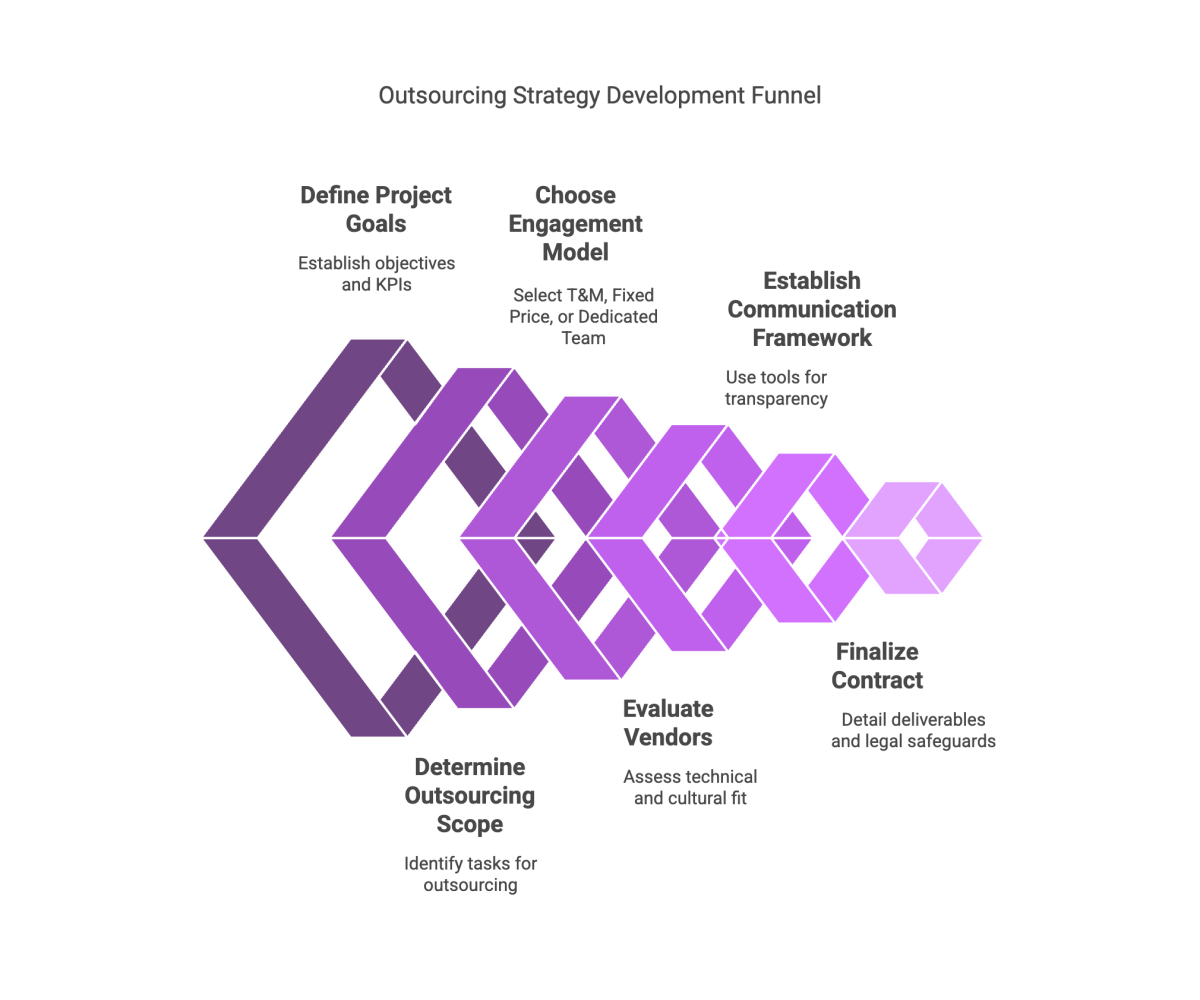

Top Risks in Outsourcing—and How to Mitigate Them
Outsourcing software development introduces several risks that must be carefully managed to ensure project success. One major risk is the loss of project visibility, where limited control over timelines and deliverables can lead to delays. This risk can be mitigated by implementing Agile ceremonies and using collaborative tools that offer real‑time tracking of progress.
Data security and intellectual property risks are also significant concerns; enforcing strict NDAs and verifying vendor security certifications (such as ISO 27001) are essential to protect sensitive information. Misaligned expectations due to scope changes can be managed by defining a detailed Statement of Work (SoW) and applying Agile backlog refinement practices. Cultural and communication gaps, as well as hidden costs arising from poor documentation, should be addressed by selecting vendors with strong communication skills and clear contractual terms.
How to Maintain Project Oversight?
To prevent loss of visibility, implement agile tracking tools like Jira or Trello, set up shared repositories, and conduct weekly demos or retrospectives. Assign a dedicated in-house project owner to facilitate daily standups and provide real-time feedback. Continuous collaboration ensures alignment across both teams.
Ensuring IP and Data Protection During Outsourcing
Start with legally binding NDAs and include IP clauses in your master service agreement. Work with vendors who follow best-in-class security protocols, including role-based access controls, end-to-end encryption, and ISO 27001 or SOC 2 compliance. If applicable, verify adherence to GDPR or HIPAA standards to safeguard user data and maintain regulatory compliance.
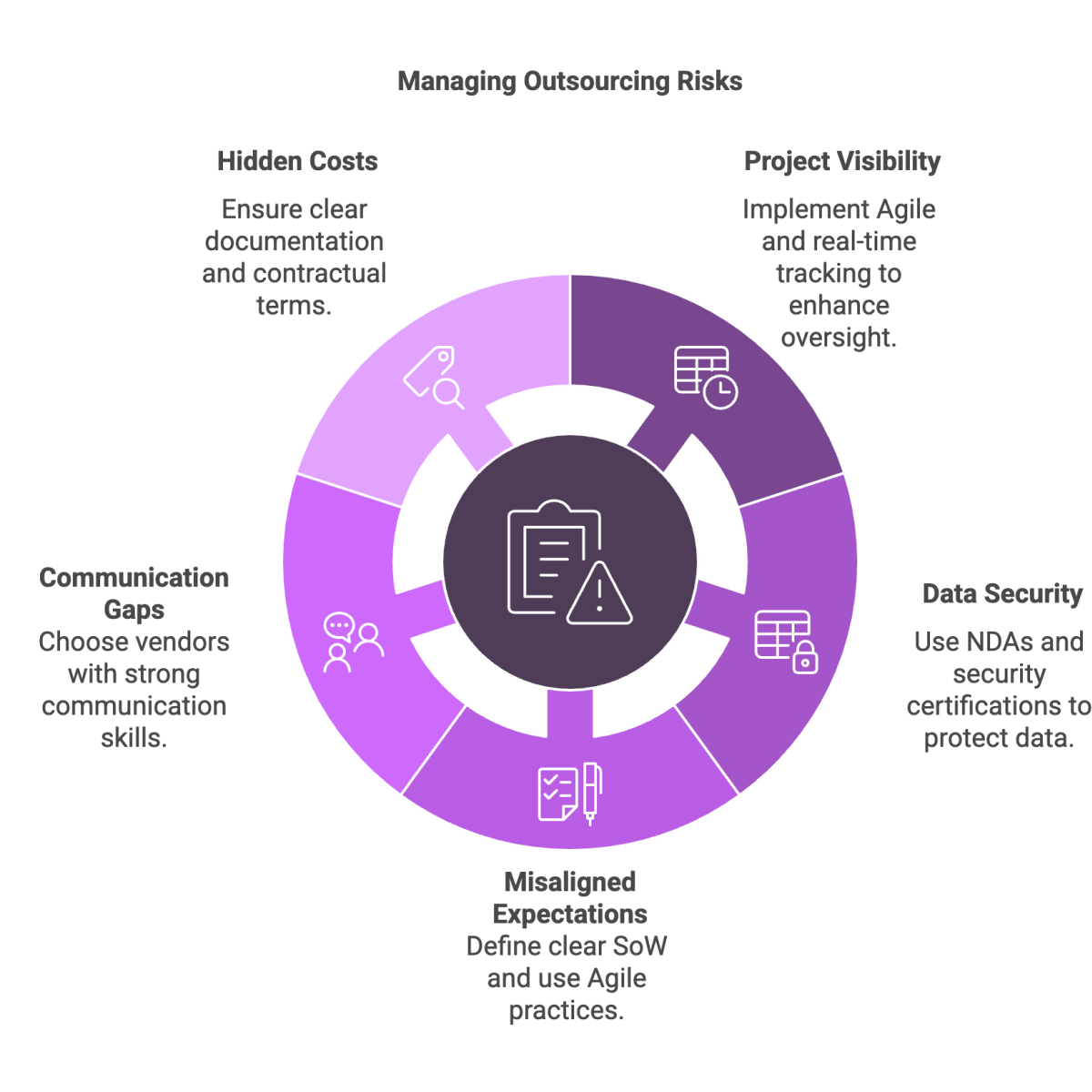

Cost Considerations by Region (2025 Estimates)
While cost is a critical factor in outsourcing decisions, it is important to consider it alongside other factors such as team reliability, code quality, and communication practices. Cost elements include the project scope and complexity, which drive development time and resource allocation, as well as the geographic region of the vendor.
For example, vendors in North America typically charge higher hourly rates compared to those in Latin America, Eastern Europe, South Asia, or Southeast Asia. Each region offers its own advantages in terms of expertise, cultural alignment, and operational efficiency. Evaluating these factors holistically will help ensure that you select a vendor who not only offers competitive rates but also delivers consistent quality and reliability throughout the project lifecycle.
Regional Price Benchmarks for Software Development Outsourcing
Outsourcing rates vary significantly based on geography, talent availability, and local economic factors. In 2025, average hourly rates for software development remain highest in North America ($100–$150), where demand for advanced tech and compliance-heavy services is strong.
Eastern Europe, known for its strong engineering education, offers competitive rates around $35–$60 per hour, while maintaining high code quality. Latin America sits in the mid-tier range, charging $40–$80 per hour and offering convenient time-zone alignment for U.S. businesses.
Asia, particularly India, the Philippines, and Vietnam, remains the most cost-effective region at $20–$50 per hour, ideal for scaling large projects on tighter budgets.
Factors That Influence Regional Pricing
Labor costs are not the sole driver of outsourcing pricing. Vendor maturity, industry specialization, security standards, and language proficiency also play critical roles. For example, a provider in India with ISO 27001 certification and AI/ML expertise may charge a premium compared to a generalist firm without credentials. Time zone differences and cultural alignment can affect coordination overhead—making nearshore or onshore vendors more attractive for projects requiring real-time collaboration. Additionally, countries with strong IP enforcement laws, like Poland or Argentina, tend to attract enterprise clients seeking added legal protection, even if their rates are slightly higher than regional averages.
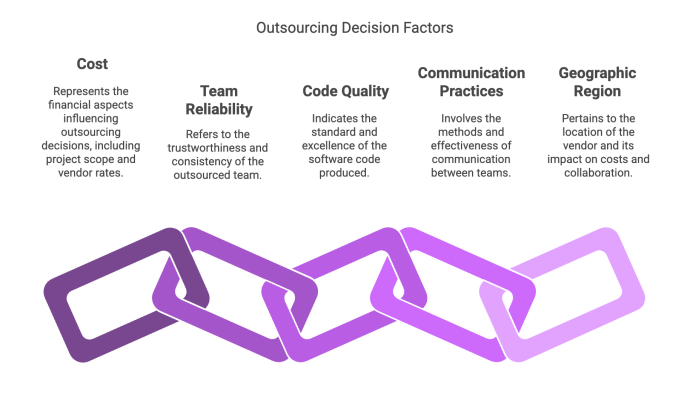

Frequently Asked Questions About Outsourcing
This section addresses some common questions regarding software development outsourcing, providing clarity on its definition, models, and best practices. These FAQs are designed to help you navigate the decision‑making process and ensure that you choose an outsourcing strategy that aligns with your business goals while minimizing risks.
- What is software development outsourcing? – It is the practice of hiring an external vendor to handle part or all of a software project, covering development, design, testing, and maintenance tasks.
- What are the best outsourcing models? – Common models include Time‑and‑Materials (T&M) for flexible, evolving projects, Fixed Price (FP) for well‑defined scopes, and Dedicated Team models for long‑term, integrated partnerships.
- How do I choose the right outsourcing partner? – Focus on evaluating the vendor’s technical expertise, industry experience, communication practices, legal protections for data and IP, and verified client references.
- How can outsourcing improve time‑to‑market? – External teams often follow Agile methodologies, enabling rapid development cycles, continuous feedback, and faster deployment of products.
- What measures can mitigate risks in outsourcing? – Establish clear scopes, detailed Statements of Work (SoW), robust NDAs, and regular Agile ceremonies to ensure transparency and accountability.
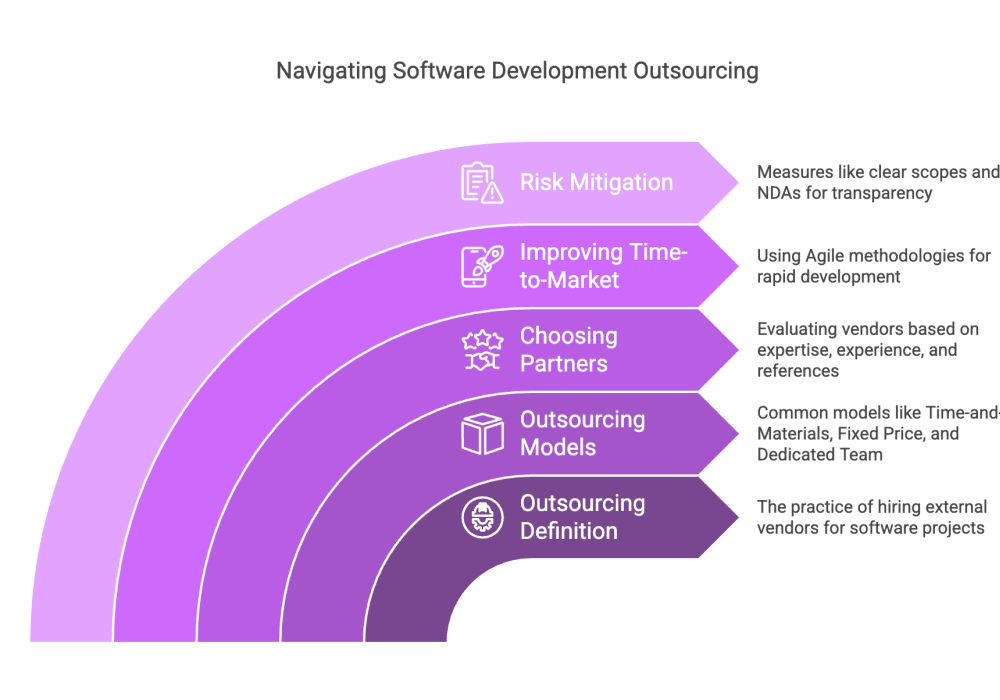

Final Thoughts
Outsourcing software development is not just a cost‑saving tactic—it’s a strategic growth tool that can enhance your technical capabilities and accelerate innovation. From MVPs to enterprise‑scale platforms, a well‑chosen outsourcing partner can streamline your project delivery, reduce overhead costs, and ensure high‑quality results that align with your business objectives. By defining clear goals, selecting the right engagement model, and establishing robust communication and legal frameworks, you can mitigate risks and unlock significant value from outsourcing.
In today’s competitive market, success in software development relies on agility, efficiency, and the ability to harness global expertise. Whether you are a startup aiming to innovate rapidly or an established enterprise looking to modernize legacy systems, outsourcing offers a flexible and scalable solution to drive sustainable growth.
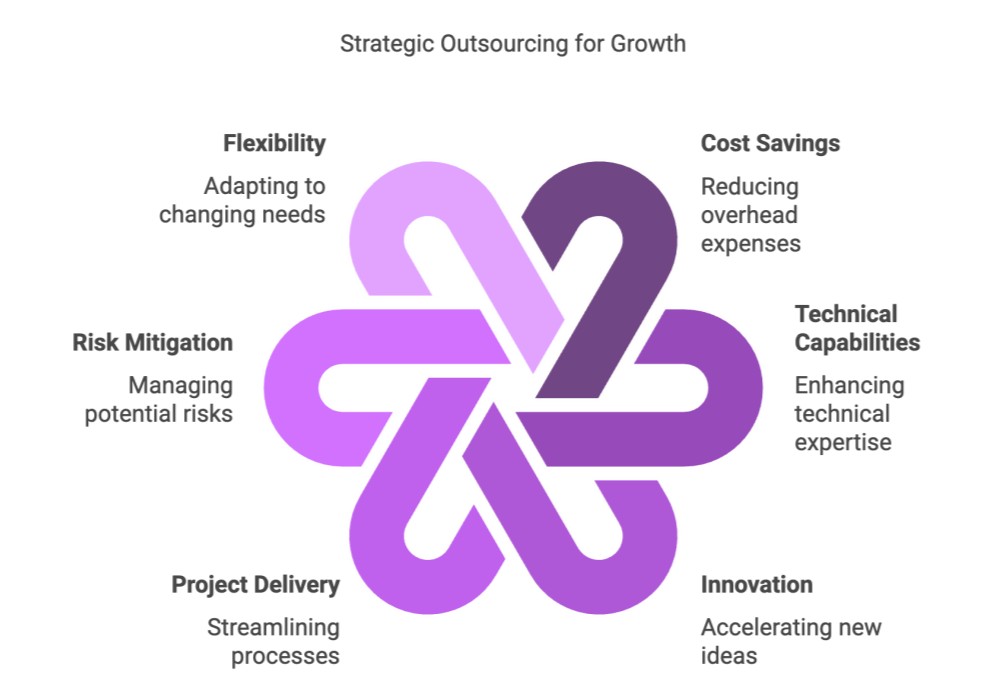

Get in Touch With Us
If you’re ready to explore how outsourcing software development can accelerate your project and drive innovation, contact us today. Our expert team is here to help you build a strategy that maximizes efficiency, minimizes risk, and delivers high‑quality results tailored to your business objectives.
